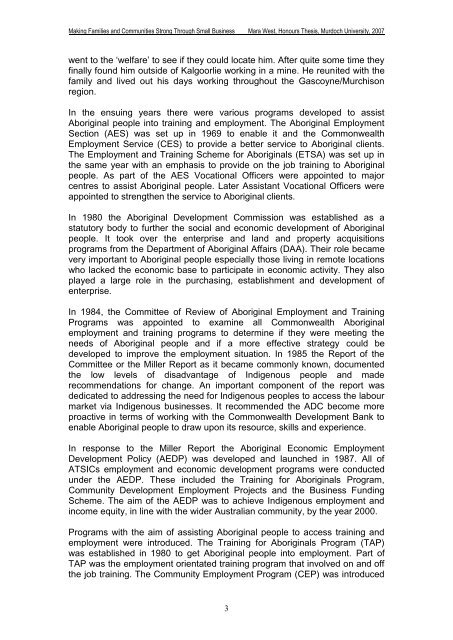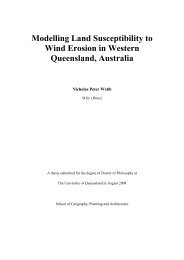MAKING FAMILIES AND COMMUNITIES STRONG THOUGH SMALL BUSINESS
making families and communities strong though small ... - Ninti One
making families and communities strong though small ... - Ninti One
- No tags were found...
Create successful ePaper yourself
Turn your PDF publications into a flip-book with our unique Google optimized e-Paper software.
Making Families and Communities Strong Through Small Business Mara West, Honours Thesis, Murdoch University, 2007went to the ‘welfare’ to see if they could locate him. After quite some time theyfinally found him outside of Kalgoorlie working in a mine. He reunited with thefamily and lived out his days working throughout the Gascoyne/Murchisonregion.In the ensuing years there were various programs developed to assistAboriginal people into training and employment. The Aboriginal EmploymentSection (AES) was set up in 1969 to enable it and the CommonwealthEmployment Service (CES) to provide a better service to Aboriginal clients.The Employment and Training Scheme for Aboriginals (ETSA) was set up inthe same year with an emphasis to provide on the job training to Aboriginalpeople. As part of the AES Vocational Officers were appointed to majorcentres to assist Aboriginal people. Later Assistant Vocational Officers wereappointed to strengthen the service to Aboriginal clients.In 1980 the Aboriginal Development Commission was established as astatutory body to further the social and economic development of Aboriginalpeople. It took over the enterprise and land and property acquisitionsprograms from the Department of Aboriginal Affairs (DAA). Their role becamevery important to Aboriginal people especially those living in remote locationswho lacked the economic base to participate in economic activity. They alsoplayed a large role in the purchasing, establishment and development ofenterprise.In 1984, the Committee of Review of Aboriginal Employment and TrainingPrograms was appointed to examine all Commonwealth Aboriginalemployment and training programs to determine if they were meeting theneeds of Aboriginal people and if a more effective strategy could bedeveloped to improve the employment situation. In 1985 the Report of theCommittee or the Miller Report as it became commonly known, documentedthe low levels of disadvantage of Indigenous people and maderecommendations for change. An important component of the report wasdedicated to addressing the need for Indigenous peoples to access the labourmarket via Indigenous businesses. It recommended the ADC become moreproactive in terms of working with the Commonwealth Development Bank toenable Aboriginal people to draw upon its resource, skills and experience.In response to the Miller Report the Aboriginal Economic EmploymentDevelopment Policy (AEDP) was developed and launched in 1987. All ofATSICs employment and economic development programs were conductedunder the AEDP. These included the Training for Aboriginals Program,Community Development Employment Projects and the Business FundingScheme. The aim of the AEDP was to achieve Indigenous employment andincome equity, in line with the wider Australian community, by the year 2000.Programs with the aim of assisting Aboriginal people to access training andemployment were introduced. The Training for Aboriginals Program (TAP)was established in 1980 to get Aboriginal people into employment. Part ofTAP was the employment orientated training program that involved on and offthe job training. The Community Employment Program (CEP) was introduced3
















